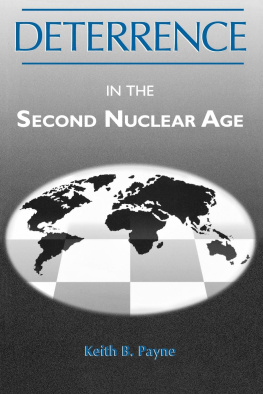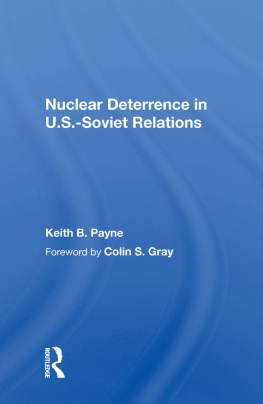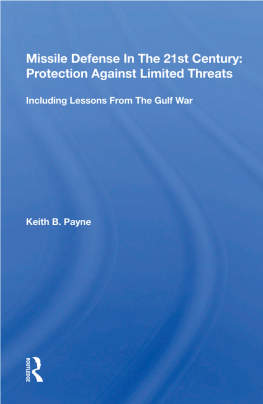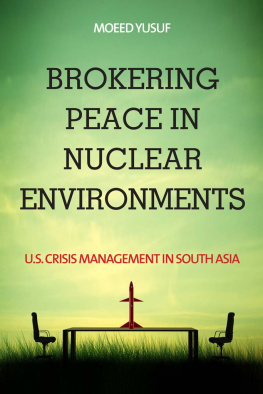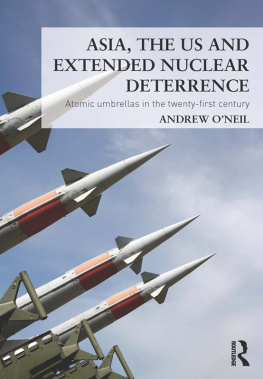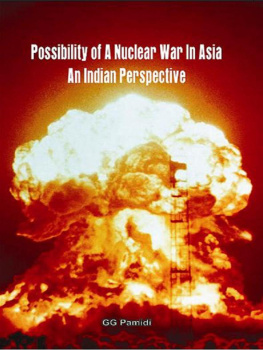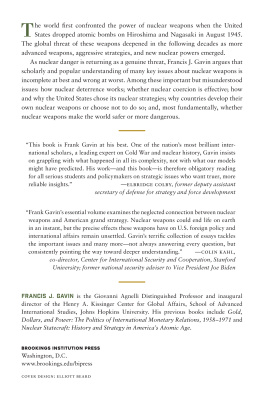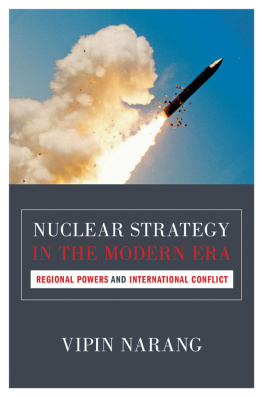Deterrence
in the
Second Nuclear Age
Deterrence
in the
Second Nuclear Age
Keith B. Payne
Copyright 1996 by The University Press of Kentucky
Scholarly publisher for the Commonwealth,
serving Bellarmine University, Berea College, Centre
College of Kentucky, Eastern Kentucky University,
The Filson Historical Society, Georgetown College,
Kentucky Historical Society, Kentucky State University,
Morehead State University, Murray State University,
Northern Kentucky University, Transylvania University,
University of Kentucky, University of Louisville,
and Western Kentucky University.
All rights reserved.
Editorial and Sales Offices: The University Press of Kentucky
663 South Limestone Street, Lexington, Kentucky 40508-4008
www.kentuckypress.com
Cataloging-in-Publication Data is available from
the Library of Congress.
ISBN 978-0-8131-0895-7 (pbk: acid-free paper)
This book is printed on acid-free recycled paper meeting
the requirements of the American National Standard
for Permanence in Paper for Printed Library Materials.
Manufactured in the United States of America.
| Member of the Association of
American University Presses |
For little Sarah,
full of joy
Contents
Foreword
Why did the great Cold War not conclude with a nuclear World War III? Were we clever, or lucky, or both? Did our policies of nuclear deterrence prevent a war that otherwise would have occurred? In Deterrence in the Second Nuclear Age, Keith Payne sets out neither to praise deterrence nor to bury it. Indeed in a major achievement he has administered a distinctly nonroutine examination of deterrence, without killing the patient.
All too rarely, genuinely important books appear on the broad subject of national and international security. This book is one such. I invite anyone skeptical of the promise of novelty concerning the theory and practice of deterrence to put their skepticism aside and give this study a chance. In a carefully nuanced assessment, Payne argues that the general theory of deterrence is attractive but that general theory always requires translation for local conditions. We may be masters of deterrence theory, but do we knowreally know with any appreciable confidencehow to deter the leaders of a particular government, on particular issues, at a particular time? The answer here is a cautionary not likely.
Unfortunately, many current and past policymakers have not understood this caveat. Keith Payne reminds us that deterrence is a relational variable; a would-be foe has to choose to be deterred. And, most important, the United States by its word and deed cannot control that choice.
This book advises sensibly that whatever deterrence can accomplish it should be allowed to accomplish. Yet there are significant limits to the practicable scope for, and efficacy of, a strategy of deterrence. Payne shows, on the one hand, truly how rough and ready our possible success with deterrence in the Cold War may have been (again, were we lucky?), and how much more strenuous still are the tests for deterrence likely to be in the future.
Here, in one concise text, is a readable, constructive, empathic critique of past deterrence theory and would-be practice that both highlights what needs saving from nearly half a century of scholarship and policy, and exposes relentlessly our persisting errors in logic and frailties in behavior, the consequences of which can be fatal. Readers will not find herein any stale replay of yesterdays debates. The argument of the book is rooted firmly in history, but is both forward looking in purpose and nonpolemical in style. Payne does not conceal his distaste for the concept and practice of Assured Vulnerability, but the edge of his argument cuts away at error on all sides of defense debate. He exposes the fallacies in the widespread expectation that deterrence can be made reliable and predictablean expectation that reflects a fundamental confusion about the subject, but nevertheless is held across the political spectrum.
Deterrence in the Second Nuclear Age is, in a very real sense, quite a shocking book. Many readers will discover that Paynes moderate and balanced prose contains a near heretical but also inescapable message. Specifically, the U.S. government, and the host of experts who advise it, actually know a great deal less about the practicability of deterrence (which is to say about war, peace, and survival) than they think they know. Payne does not allege that these people are deliberately advancing lethal falsehoods. The situation in reality is more dangerous than that. There is peril in the misplaced self-confidence of officials and advisers who believe they know how to deter. Their resultant bravado should frighten us all.
Keith Paynes tour de force has been many years in gestation. This is a mature book that should influence noticeably both the course of scholarship anddare one be so optimistic?the path of public policy and national security strategy. This is a book that can make a difference to our security.
Colin S. Gray
Professor of International Politics and
Director of the Centre for Security Studies
University of Hull, England
Preface
No one had time for a deliberate aim or time to think.... There is no mystery about the outbreak of the First World War. The deterrent failed to deter. This was to be expected sooner or later. A deterrent may work ninety-nine times out of a hundred. On the hundredth occasion it produces catastrophe. There is a contemporary moral here for those who like to find one.
A.J.P. Taylor, War By Timetable
The focus of this book is on deterrence. During the Cold War deterrence of the Soviet Union was the leitmotiv of U.S. and NATO military strategy. In the United States the question of how best to deter the Soviet Union was at the heart of the debate about nuclear weapons and most other controversies concerning arms control agreements and specific strategic weapons programs.
The rancorous debates about the MX ICBM, the Strategic Defense Initiative (popularly known as Star Wars), the nuclear freeze initiatives of the early 1970s and early 1980s, and the SALT II agreement, for example, generally reflected underlying differences over the requirements for deterrence. These highly visible controversies that seemed to revolve around technical-sounding issues and considerations truly represented only the tip of an iceberg; the larger underlying issue was how to deter the Soviet Union.
The question of how to deter will be as important in the postCold War era as it was during the Cold War. Yet, as the 1991 war with Iraq foreshadowed, the question of how to deter will increasingly have to be broadened to include so-called regional rogue powers. The convenience of focusing largely on a single adversary in this regard is over.
This by no means is to suggest an expectation that the Russian Federation is likely to be an insignificant or necessarily benign player on the postCold War world stage. Rather, additional states are acquiring the instruments of power to compel the broadening of our scope concerning the question of how to deter. In particular, the proliferation of weapons of mass destruction (WMD) and advanced missile systems is causing us to take increasing notice of regional powerspowers that in the past may have been of interest primarily or solely for the role they might have played in the great East-West contest.

